SEO
How to Promote Your Blog: 7 Proven Strategies

Search for “how to promote your blog,” and you’ll see hundreds of strategies.
But not all of them work. Believe us—we’ve tried them.
These are the seven that have worked for us.
People are more likely to share content with unique insights. Data, experiences, opinions—anything they can’t find elsewhere.
Here’s an example that illustrates this. In 2015, our chief marketing officer, Tim Soulo, wrote a guide to strategic writing on his personal blog. He crammed everything he knew and thought he created a masterpiece.
Yet, when he asked marketing influencer Rand Fishkin to tweet the post, this was how Rand responded:

A few years later, Rand retweeted our post on podcast advertising without any prompting:
What was the difference?
In Tim’s post, he rehashed the same advice from other articles on the topic. No doubt it was useful, but nothing was unique. In the latter article by our Rebekah Bek, everything was solely based on experience.
I’m not going to simply just tell you to create “unique content.” You must have heard it a hundred times by now. So rather than repeating the same old advice, I recommend building share triggers instead.
Coined by professor Jonah Berger in his book, “Contagious,” share triggers are psychological principles that make people want to share something. They are:
- Social currency – People share things that make them look good to others.
- Triggers – People share things that are top of mind.
- Emotion – People need to feel something to share something.
- Public – People tend to imitate others’ behavior if they can see or observe it.
- Practical value – People like to pass along practical, useful information.
- Stories – People don’t just share information—they share stories too.
Here’s how to put them into action (you’ll want to incorporate at least one or two):
- Make your content practical – Create something the reader can use right away. For example, our suite of free tools generates a lot of links and shares.
- Make your content opinionated – Give the reader something new to think about. Tim’s rant on email outreach and our post on podcast advertising are some examples of opinionated content.
- Evoke emotion – People used to share Upworthy articles because those made them feel awe, surprise, and happiness. Appealing to these emotions—alongside negative ones like anger and sadness—can compel people to share more.
- Make your content visual – Visual content makes consuming content easier, thus increasing the likelihood that someone will share it.
- Make your content newsworthy – Journalists and bloggers are constantly on the lookout for stories to cover. Data is one type of story. So if you have unique data to share, create a piece of content around it.
- Tell a story – Humans love telling and sharing stories. A good story that captures people’s attention can lead to more shares.
- Include what other people are sharing – If people are sharing and linking because of certain reasons in competing pages, we can assume that those reasons are important to that topic.
For the final tip, here’s how you can find out why people are linking:
- Go to Ahrefs’ Keywords Explorer
- Search for a topic you’re writing about
- Look at the SERP overview
- Find a similar article with lots of referring domains
- Click on the number in the Backlinks column
- Skim the Anchor and target URL column for commonalities
For example, if we analyze this post on the perfect kettlebell swing, we see that people are linking because of the benefits:

It’s something we can consider adding to our content.
Learn more: What Is Link Bait? 7 Successful Examples
You want traffic from Google. But if you’re new to the game, many topics are out of your reach—at least for now. They’re too competitive, and you’re outgunned by websites with more resources.
But what if I tell you that you can find topics that are easy to rank for? Here’s how:
- Go to Ahrefs’ Content Explorer
- Search for a relevant term (e.g., “beards”)
- Add a Referring domains filter to max. 10
- Add a Page traffic filter to min. 500
- Add a Domain Rating filter to max. 30
Since backlinks are an important ranking factor, pages that still get tons of search traffic without plenty of backlinks should be relatively easy to rank for.

In this example, you’ll see >2,000 pages that get >500 search traffic a month with fewer than 10 referring domains.
Click on any article and then on the Organic keywords tab to see what keywords they’re ranking for.

If you’re running a blog about beards, you can target the same topics too.
Learn more: How to Find Low-Competition Keywords for SEO
If you’ve published an amazing piece of content, why not show it to people in your niche who have a large audience?
It’s why Tim reached out to Rand. In digital marketing, we call this “outreach.”
The key to successful outreach is to ask yourself this question each time you’re about to send a new email:
Why would anyone care about whatever I say?
There are two strong outreach reasons:
- You mentioned that person (or their work) in your article.
- Your article has something groundbreaking that this person doesn’t know about but is genuinely interested in.
The latter reason is why strategy #1 works. There’s no trick to getting top people in your field to promote you. You have to do notable work.
This is also why whenever we send outreach emails to promote our content, we focus on pitching the article—not a sneaky request to tweet it.

Assuming you’ve created something noteworthy, here’s how you can find people to potentially reach out to:
- Go to Ahrefs’ Content Explorer
- Search for your topic
- Click on the Authors tab

These 100 people have written many articles on your topic, so it’s reasonable to assume they’re interested. Find their emails, reach out to them, and share your unique insights.
Learn more: Blogger Outreach: How to Do It at Scale (Without Feeling Like a Jerk)
Here’s another strong reason you can use for your outreach: You noticed someone’s blog post is declining in traffic, so you offer to help update it.
In fact, this was what Irina Maltseva, the former head of marketing at Hunter, did:

Why does this work? Four reasons:
- It is important to update older content—you don’t want outdated information, and updated content helps boost search traffic.
- Keeping track and updating old content are burdensome tasks. By offering to update old content, you’re offering to take it off their hands.
- While guest blogging is a legitimate way to drive traffic, you’re oftentimes “guessing” the kind of topics they’re interested in. But you don’t need to guess if you’re updating their old content.
- They’re more than likely to allow you to link back to your site and/or your content.
Here’s how you can find content that’s declining in traffic:
- Go to Ahrefs’ Content Explorer
- Search for your topic
- Set the Trends dropdown to Last year
From here, you’ll want to eyeball the list and look out for pages with declining page traffic:

Click on the article to see the Page traffic chart in detail:

Looks like this particular article has suffered a drastic drop in traffic. If you’re in this niche, you can reach out to the editor and see if they’ll be interested in updating the post. If they are, suggest doing the work for them—it’ll sweeten the ask.
Learn more: Republishing Content: How to Update Old Blog Posts for SEO
There is a subreddit for almost anything. That includes your niche too. There’s no doubt that Reddit is a great place to promote your content. Do it right, and it may even lead to a hug of death.
But let me throw a wrench in your plans. Redditors hate advertising and marketing. If your content smells like self-promotion, they will not hesitate to throw you out.
So you can’t just waltz in, drop a link, and wait for the flood of traffic.
Reddit, however, does love useful content. So to resolve this conundrum, you can share a barebones version of your content. Strip everything out, especially your internal and external links. Leave only a link back to the original at the bottom of your Reddit post, so anyone who’s interested can check it out.
Here’s an example of it in the wild:

We have a video on blog post templates you can swipe. But did you know that it was originally a blog post?
Not everyone wants to read. Some want to watch videos. By turning your articles into videos, you can potentially reach a new set of audience.
You’ve already created the content anyway. Why not take advantage of it and give it a new lease on life?
Let’s be honest, though. Repurposing is hard work. It’s one thing to say, “Turn your blog post into a video,” and another to actually do it. So if you’re going down this path, you’ll have to prioritize.
One way to do this is to focus on topics that people are already searching for on YouTube. That way, your repurposed videos can generate search traffic too.
Here’s how to find these topics:
- Go to Ahrefs’ Keywords Explorer
- Select YouTube
- Enter a few relevant keywords
- Go to the Matching terms report

Look through the list to see if there are any topics where you already have existing blog content. Those are the topics you should repurpose.
For example, this was how we decided to repurpose our article on influencer marketing:

Learn more: The Complete Guide to Content Repurposing
Most people who are looking for ways to promote their blogs are actually looking for free promotion strategies. They don’t want to pay for promotion because they think they have no budget for it.
But what they don’t realize is that, in reality, no blog promotion method is free. While it may not cost upfront cash, it takes time. And time is money. Even the richest person in the world cannot buy time.
So you actually do have the budget to promote your content with ads because they free up your precious time—time that could be better spent elsewhere.
At Ahrefs, we run ads for all our newly published content. Facebook ads are our go-to:

If you find Facebook ads too complex or too expensive, don’t forget that there are other platforms you can test too. For example, we also run ads on Quora:

And Twitter:

Learn more: PPC Marketing: Beginner’s Guide to Pay-Per-Click Ads
Final thoughts
Ryan Holiday writes in “Perennial Seller”:
Creating more work is one of the most effective marketing techniques of all.
If you’ve published an amazing article and got tons of success, the best thing you can do to promote your blog further is to publish another amazing piece of content.
A consistent output of great work is the foundation behind all your blog promotion strategies. It supercharges everything.
Any questions or comments? Let me know on Twitter.
SEO
Measuring Content Impact Across The Customer Journey

Understanding the impact of your content at every touchpoint of the customer journey is essential – but that’s easier said than done. From attracting potential leads to nurturing them into loyal customers, there are many touchpoints to look into.
So how do you identify and take advantage of these opportunities for growth?
Watch this on-demand webinar and learn a comprehensive approach for measuring the value of your content initiatives, so you can optimize resource allocation for maximum impact.
You’ll learn:
- Fresh methods for measuring your content’s impact.
- Fascinating insights using first-touch attribution, and how it differs from the usual last-touch perspective.
- Ways to persuade decision-makers to invest in more content by showcasing its value convincingly.
With Bill Franklin and Oliver Tani of DAC Group, we unravel the nuances of attribution modeling, emphasizing the significance of layering first-touch and last-touch attribution within your measurement strategy.
Check out these insights to help you craft compelling content tailored to each stage, using an approach rooted in first-hand experience to ensure your content resonates.
Whether you’re a seasoned marketer or new to content measurement, this webinar promises valuable insights and actionable tactics to elevate your SEO game and optimize your content initiatives for success.
View the slides below or check out the full webinar for all the details.
SEO
How to Find and Use Competitor Keywords

Competitor keywords are the keywords your rivals rank for in Google’s search results. They may rank organically or pay for Google Ads to rank in the paid results.
Knowing your competitors’ keywords is the easiest form of keyword research. If your competitors rank for or target particular keywords, it might be worth it for you to target them, too.
There is no way to see your competitors’ keywords without a tool like Ahrefs, which has a database of keywords and the sites that rank for them. As far as we know, Ahrefs has the biggest database of these keywords.
How to find all the keywords your competitor ranks for
- Go to Ahrefs’ Site Explorer
- Enter your competitor’s domain
- Go to the Organic keywords report
The report is sorted by traffic to show you the keywords sending your competitor the most visits. For example, Mailchimp gets most of its organic traffic from the keyword “mailchimp.”


Since you’re unlikely to rank for your competitor’s brand, you might want to exclude branded keywords from the report. You can do this by adding a Keyword > Doesn’t contain filter. In this example, we’ll filter out keywords containing “mailchimp” or any potential misspellings:
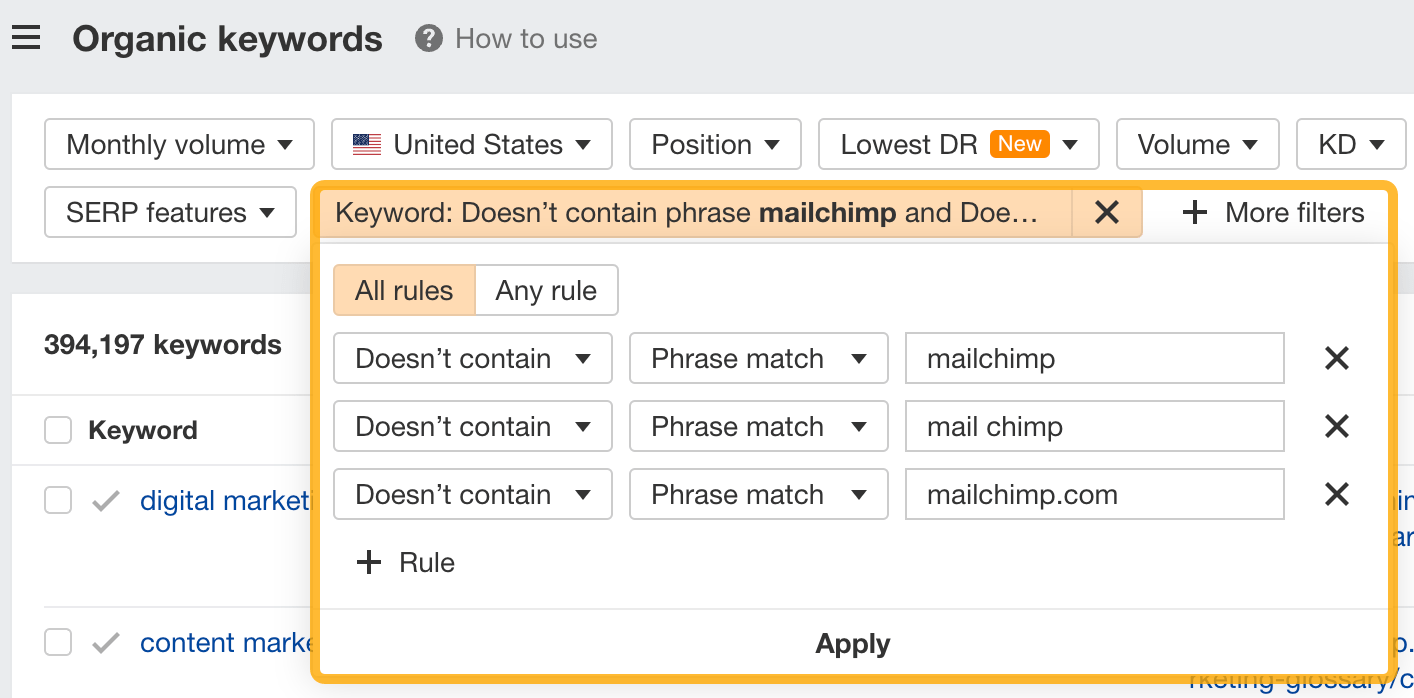

If you’re a new brand competing with one that’s established, you might also want to look for popular low-difficulty keywords. You can do this by setting the Volume filter to a minimum of 500 and the KD filter to a maximum of 10.


How to find keywords your competitor ranks for, but you don’t
- Go to Competitive Analysis
- Enter your domain in the This target doesn’t rank for section
- Enter your competitor’s domain in the But these competitors do section


Hit “Show keyword opportunities,” and you’ll see all the keywords your competitor ranks for, but you don’t.


You can also add a Volume and KD filter to find popular, low-difficulty keywords in this report.


How to find keywords multiple competitors rank for, but you don’t
- Go to Competitive Analysis
- Enter your domain in the This target doesn’t rank for section
- Enter the domains of multiple competitors in the But these competitors do section
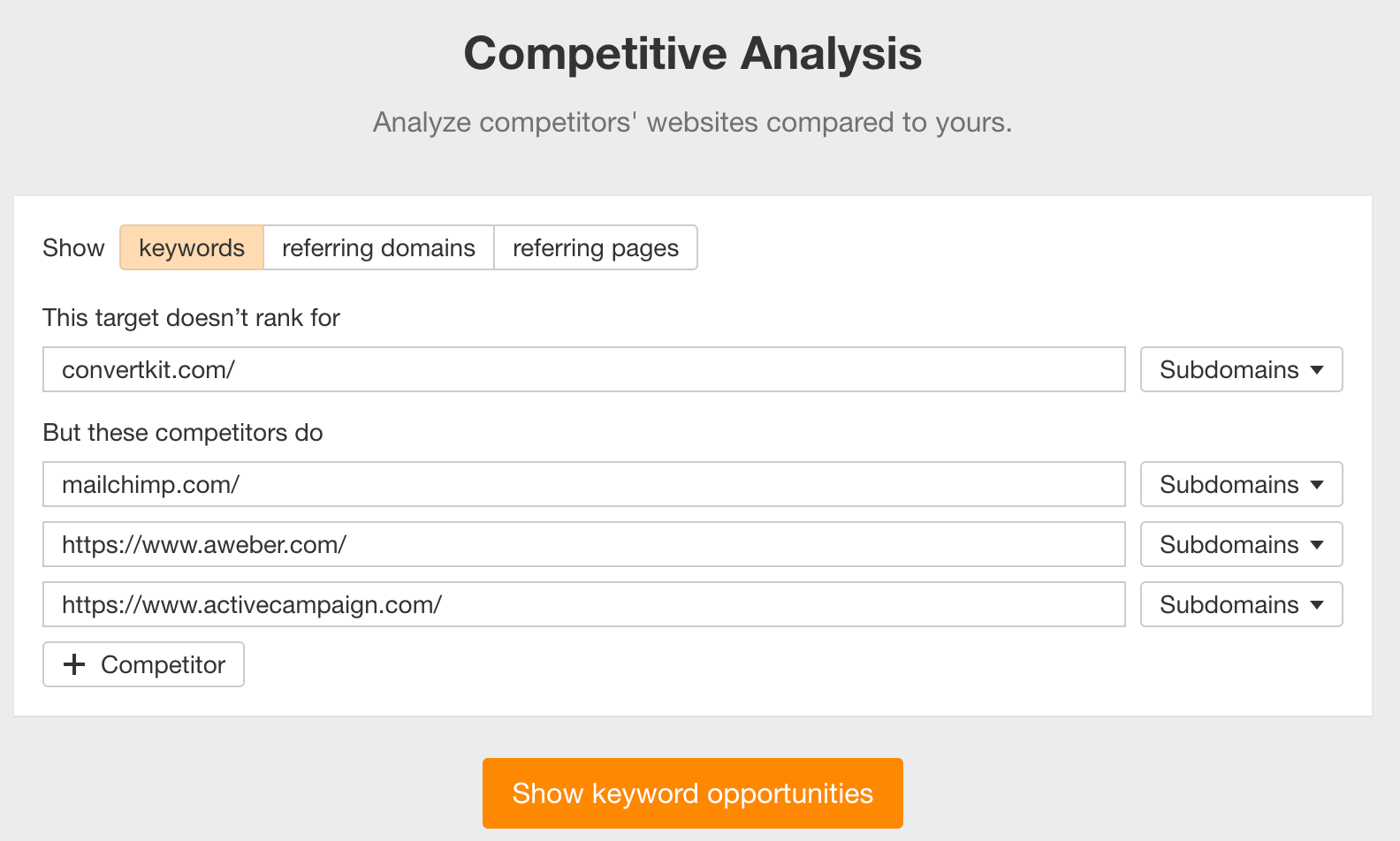

You’ll see all the keywords that at least one of these competitors ranks for, but you don’t.


You can also narrow the list down to keywords that all competitors rank for. Click on the Competitors’ positions filter and choose All 3 competitors:


- Go to Ahrefs’ Site Explorer
- Enter your competitor’s domain
- Go to the Paid keywords report
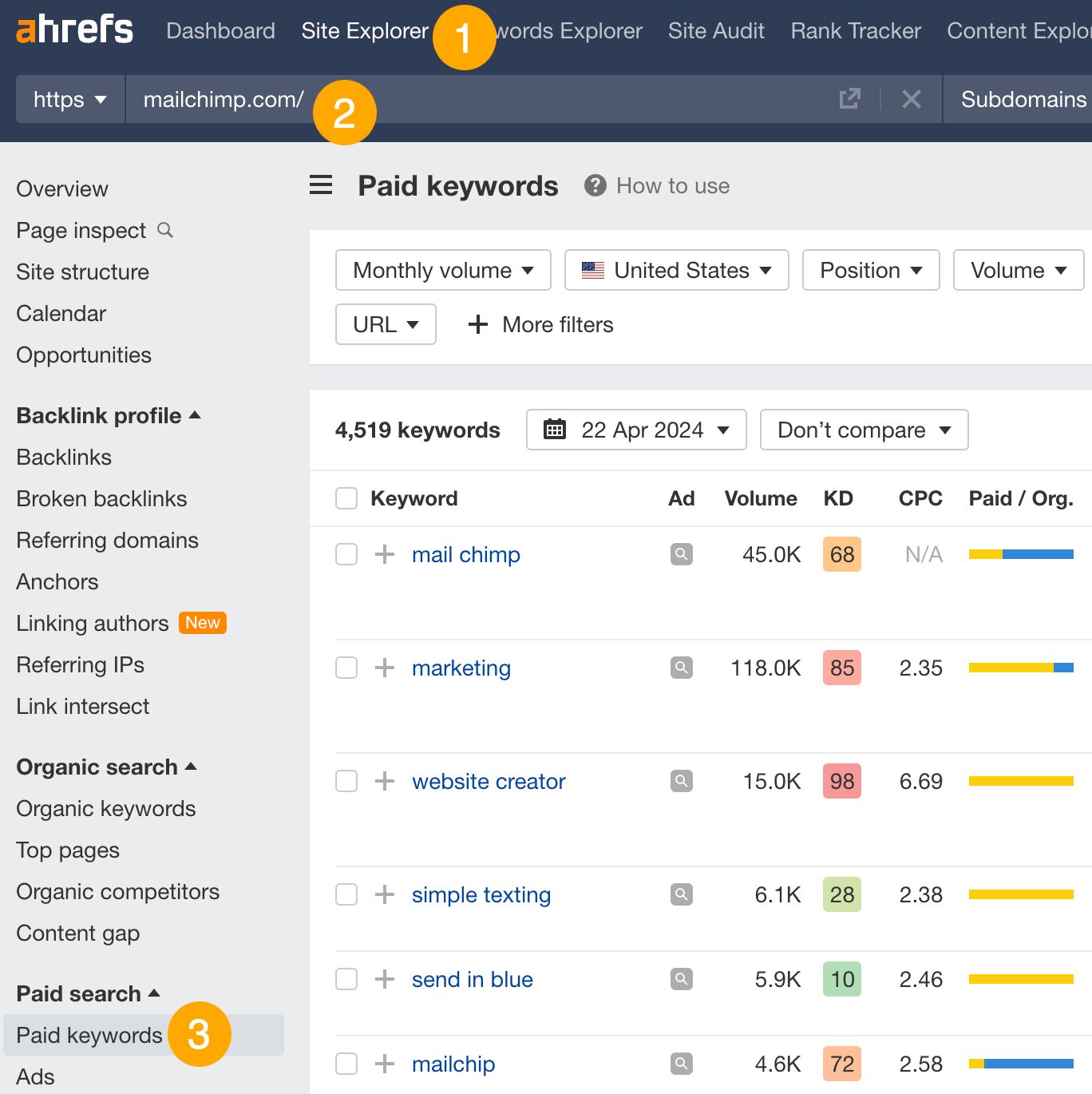

This report shows you the keywords your competitors are targeting via Google Ads.
Since your competitor is paying for traffic from these keywords, it may indicate that they’re profitable for them—and could be for you, too.
You know what keywords your competitors are ranking for or bidding on. But what do you do with them? There are basically three options.
1. Create pages to target these keywords
You can only rank for keywords if you have content about them. So, the most straightforward thing you can do for competitors’ keywords you want to rank for is to create pages to target them.
However, before you do this, it’s worth clustering your competitor’s keywords by Parent Topic. This will group keywords that mean the same or similar things so you can target them all with one page.
Here’s how to do that:
- Export your competitor’s keywords, either from the Organic Keywords or Content Gap report
- Paste them into Keywords Explorer
- Click the “Clusters by Parent Topic” tab


For example, MailChimp ranks for keywords like “what is digital marketing” and “digital marketing definition.” These and many others get clustered under the Parent Topic of “digital marketing” because people searching for them are all looking for the same thing: a definition of digital marketing. You only need to create one page to potentially rank for all these keywords.
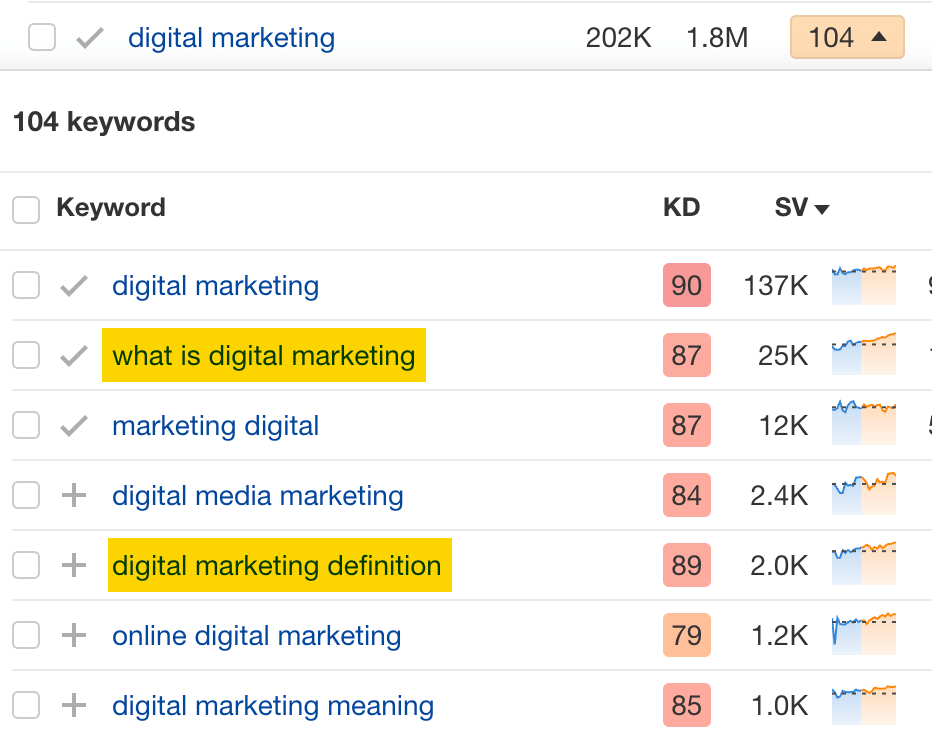

2. Optimize existing content by filling subtopics
You don’t always need to create new content to rank for competitors’ keywords. Sometimes, you can optimize the content you already have to rank for them.
How do you know which keywords you can do this for? Try this:
- Export your competitor’s keywords
- Paste them into Keywords Explorer
- Click the “Clusters by Parent Topic” tab
- Look for Parent Topics you already have content about
For example, if we analyze our competitor, we can see that seven keywords they rank for fall under the Parent Topic of “press release template.”


If we search our site, we see that we already have a page about this topic.


If we click the caret and check the keywords in the cluster, we see keywords like “press release example” and “press release format.”
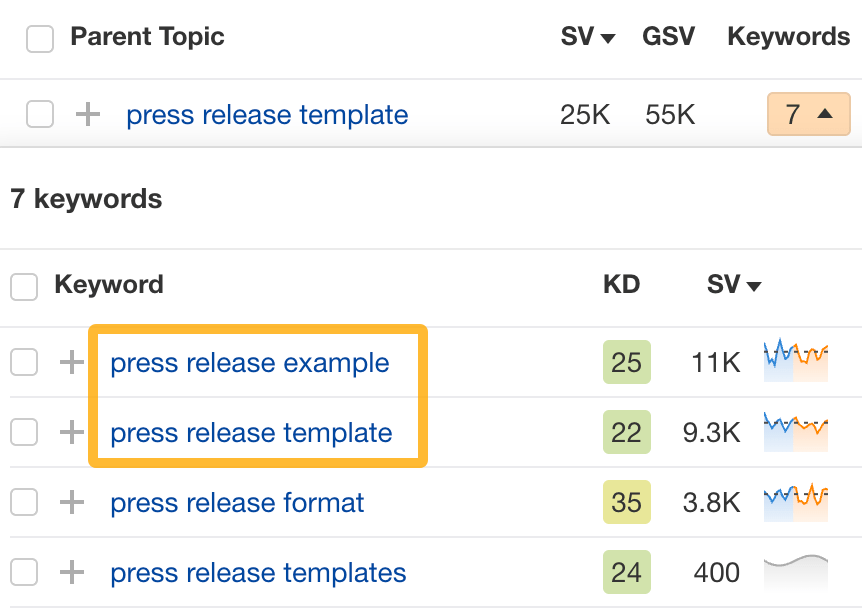

To rank for the keywords in the cluster, we can probably optimize the page we already have by adding sections about the subtopics of “press release examples” and “press release format.”
3. Target these keywords with Google Ads
Paid keywords are the simplest—look through the report and see if there are any relevant keywords you might want to target, too.
For example, Mailchimp is bidding for the keyword “how to create a newsletter.”


If you’re ConvertKit, you may also want to target this keyword since it’s relevant.
If you decide to target the same keyword via Google Ads, you can hover over the magnifying glass to see the ads your competitor is using.
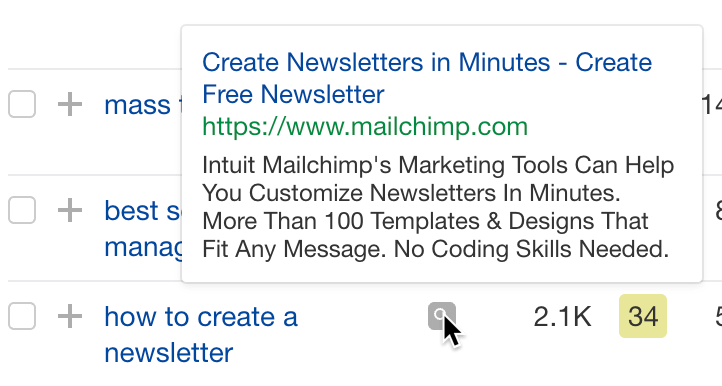

You can also see the landing page your competitor directs ad traffic to under the URL column.


Learn more
Check out more tutorials on how to do competitor keyword analysis:
SEO
Google Confirms Links Are Not That Important

Google’s Gary Illyes confirmed at a recent search marketing conference that Google needs very few links, adding to the growing body of evidence that publishers need to focus on other factors. Gary tweeted confirmation that he indeed say those words.
Background Of Links For Ranking
Links were discovered in the late 1990’s to be a good signal for search engines to use for validating how authoritative a website is and then Google discovered soon after that anchor text could be used to provide semantic signals about what a webpage was about.
One of the most important research papers was Authoritative Sources in a Hyperlinked Environment by Jon M. Kleinberg, published around 1998 (link to research paper at the end of the article). The main discovery of this research paper is that there is too many web pages and there was no objective way to filter search results for quality in order to rank web pages for a subjective idea of relevance.
The author of the research paper discovered that links could be used as an objective filter for authoritativeness.
Kleinberg wrote:
“To provide effective search methods under these conditions, one needs a way to filter, from among a huge collection of relevant pages, a small set of the most “authoritative” or ‘definitive’ ones.”
This is the most influential research paper on links because it kick-started more research on ways to use links beyond as an authority metric but as a subjective metric for relevance.
Objective is something factual. Subjective is something that’s closer to an opinion. The founders of Google discovered how to use the subjective opinions of the Internet as a relevance metric for what to rank in the search results.
What Larry Page and Sergey Brin discovered and shared in their research paper (The Anatomy of a Large-Scale Hypertextual Web Search Engine – link at end of this article) was that it was possible to harness the power of anchor text to determine the subjective opinion of relevance from actual humans. It was essentially crowdsourcing the opinions of millions of website expressed through the link structure between each webpage.
What Did Gary Illyes Say About Links In 2024?
At a recent search conference in Bulgaria, Google’s Gary Illyes made a comment about how Google doesn’t really need that many links and how Google has made links less important.
Patrick Stox tweeted about what he heard at the search conference:
” ‘We need very few links to rank pages… Over the years we’ve made links less important.’ @methode #serpconf2024″
Google’s Gary Illyes tweeted a confirmation of that statement:
“I shouldn’t have said that… I definitely shouldn’t have said that”
Why Links Matter Less
The initial state of anchor text when Google first used links for ranking purposes was absolutely non-spammy, which is why it was so useful. Hyperlinks were primarily used as a way to send traffic from one website to another website.
But by 2004 or 2005 Google was using statistical analysis to detect manipulated links, then around 2004 “powered-by” links in website footers stopped passing anchor text value, and by 2006 links close to the words “advertising” stopped passing link value, links from directories stopped passing ranking value and by 2012 Google deployed a massive link algorithm called Penguin that destroyed the rankings of likely millions of websites, many of which were using guest posting.
The link signal eventually became so bad that Google decided in 2019 to selectively use nofollow links for ranking purposes. Google’s Gary Illyes confirmed that the change to nofollow was made because of the link signal.
Google Explicitly Confirms That Links Matter Less
In 2023 Google’s Gary Illyes shared at a PubCon Austin that links were not even in the top 3 of ranking factors. Then in March 2024, coinciding with the March 2024 Core Algorithm Update, Google updated their spam policies documentation to downplay the importance of links for ranking purposes.
The documentation previously said:
“Google uses links as an important factor in determining the relevancy of web pages.”
The update to the documentation that mentioned links was updated to remove the word important.
Links are not just listed as just another factor:
“Google uses links as a factor in determining the relevancy of web pages.”
At the beginning of April Google’s John Mueller advised that there are more useful SEO activities to engage on than links.
Mueller explained:
“There are more important things for websites nowadays, and over-focusing on links will often result in you wasting your time doing things that don’t make your website better overall”
Finally, Gary Illyes explicitly said that Google needs very few links to rank webpages and confirmed it.
I shouldn’t have said that… I definitely shouldn’t have said that
— Gary 鯨理/경리 Illyes (so official, trust me) (@methode) April 19, 2024
Why Google Doesn’t Need Links
The reason why Google doesn’t need many links is likely because of the extent of AI and natural language undertanding that Google uses in their algorithms. Google must be highly confident in its algorithm to be able to explicitly say that they don’t need it.
Way back when Google implemented the nofollow into the algorithm there were many link builders who sold comment spam links who continued to lie that comment spam still worked. As someone who started link building at the very beginning of modern SEO (I was the moderator of the link building forum at the #1 SEO forum of that time), I can say with confidence that links have stopped playing much of a role in rankings beginning several years ago, which is why I stopped about five or six years ago.
Read the research papers
Authoritative Sources in a Hyperlinked Environment – Jon M. Kleinberg (PDF)
The Anatomy of a Large-Scale Hypertextual Web Search Engine
Featured Image by Shutterstock/RYO Alexandre
-

 PPC4 days ago
PPC4 days ago19 Best SEO Tools in 2024 (For Every Use Case)
-
SEARCHENGINES7 days ago
Daily Search Forum Recap: April 16, 2024
-

 SEO7 days ago
SEO7 days agoGoogle Clarifies Vacation Rental Structured Data
-

 MARKETING6 days ago
MARKETING6 days agoStreamlining Processes for Increased Efficiency and Results
-
SEARCHENGINES6 days ago
Daily Search Forum Recap: April 17, 2024
-

 SEO6 days ago
SEO6 days agoAn In-Depth Guide And Best Practices For Mobile SEO
-

 PPC6 days ago
PPC6 days ago97 Marvelous May Content Ideas for Blog Posts, Videos, & More
-
SEARCHENGINES5 days ago
Daily Search Forum Recap: April 18, 2024















You must be logged in to post a comment Login